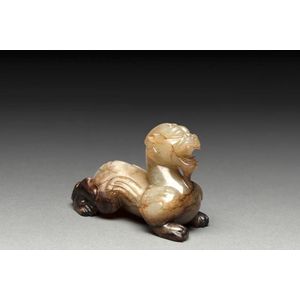
Ming Dynasty Pale White and Dark Jade Bixie Carving
A Chinese pale white and dark jade carved mythical beast, BiXIE, Ming Dynasty (1368-1644) the finely carved bixie with a pair of wings, the stone with pale white tone and areas of dark tone. 5.7 cm long

Qing Dynasty White Jade Bixie Carving
A Chinese white jade carving of two Bixie, Qing Dynasty, circa 18th century, carved from jade of even whiteish-grey hue, as a mother and cub bixie group. A private collection, Caulfield. 1.8 cm high, 3.5 cm wide

Qing Dynasty Jade Seals with Animal Motifs
Two Chinese carved jade seals, Qing Dynasty (1644-1912), one seal of fine white jade with one russet edge decorated to the top with a bixie and lingzhi fungus and mark to base. The other seal of pale celadon hue decorated to the top with a recumbent…

Chinese Qing Dynasty Jade Carvings
Three Chinese jade carvings, Qing Dynasty (1644-1912), comprising: a peach with foliage in celadon jade with russet splashes, a white jade carving of a boy, and a pair of frolicking bixie in pale celadon jade. Provenance: The Gwenneth Haines collection.…

Chinese Jades and Hardstones from Qing Dynasty
A group of Chinese jades and Hardstones, Qing Dynasty (1644-1912), comprising a celadon green rounded jade snuff bottle, an archaistic style jade bixie, a white jade archaistic pendant and a rock crystal vajra. The snuff bottle 4.5 cm high, 3.5 cm wide

Celadon Jade Bixie Figure with Lingzhi Fungus
A celadon jade figure of a bixie, 19th/20th century, (2), the recumbent animal with head turned to the side holding a lingzhi fungus frond in its mouth, the head with a double coiled horn extending to the ridged spine, and with a long tail curled over its…

Qing Dynasty White Jade Bixie Figure with Lingzhi Spray
An early Chinese white jade carved figure of a Bixie, Qing Dynasty (1644-1911), the mythical horned animal in a crouching position and carved with full rounded body, grasping a leafy 'Lingzhi' spray (the sacred mushroom) in its mouth, 8.4 cm length, with…
 Loading more...
Loading more...